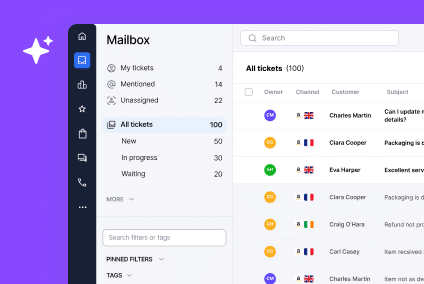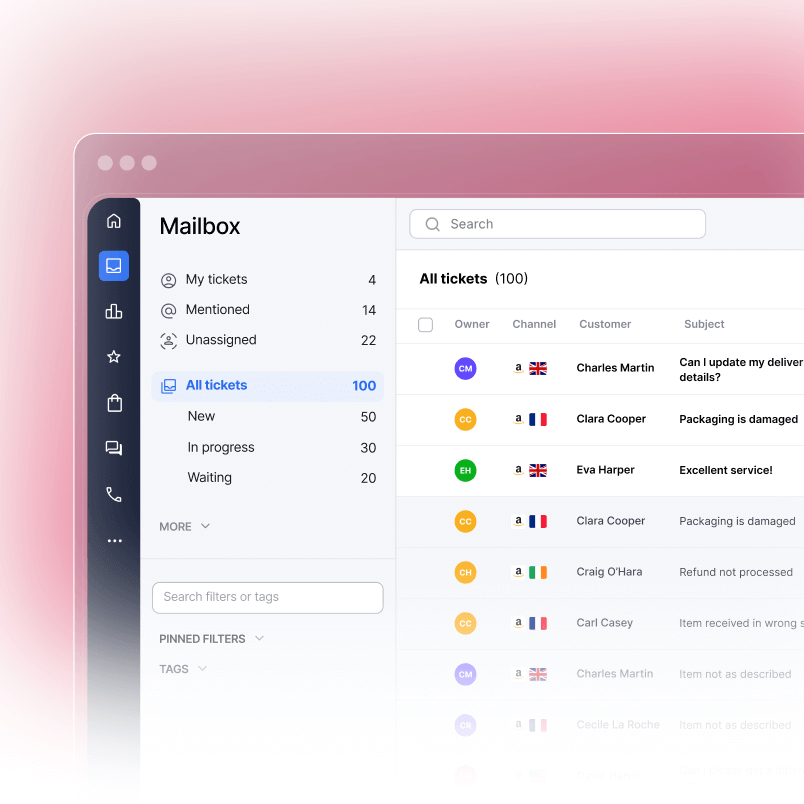If you’re an eBay seller, you don’t need us to tell you that dealing with eBay Resolution Centre cases can be a major pain point for online sellers. Between juggling open disputes, keeping track of customer communications, and making sure your responses align with eBay’s policies, there’s plenty that can go wrong. And every delay or misstep can cost you time, and seller performance points too.
But we’ve got some good news for you: it doesn’t have to be this hard.
By bringing your eBay Resolution Centre case management into your helpdesk (especially one designed with eCommerce in mind – but more on that later), you can make the process faster, simpler, and far less stressful.
This blog will walk you through the four top strategies to streamline your case management and keep your seller metrics strong, with practical tips that work even in the most hectic of inboxes.
But before we jump into the strategies, let’s remind ourselves what we’re up against.
The challenge of eBay case management
For eBay sellers, the Resolution Centre is both a safety net and a high-stakes arena. When a buyer opens a case – whether for an item not received, a return, or a refund – you’re against the clock. How you respond affects not only the outcome of the case but your overall eBay seller performance metrics. This can impact your visibility, and even your account standing.
The issue is: Most sellers juggle eBay cases separately from the rest of their customer service workload. You’ve got messages in one tab, order systems in another, and then the Resolution Centre running on its own island. It’s messy, inefficient, and (if we’re honest) easy to mess up.
When you’re trying to resolve issues quickly and professionally, switching between systems slows you down and increases the risk of missing key info, replying without context, or delaying your response altogether. In other words, you’re on the fast-track to poor metrics and frustrated buyers.
Sure, managing eBay cases manually might be doable at a small scale. But once your store starts growing – or during peak periods – it becomes a real liability.
So, what’s the alternative?
Why integrate case handling with your helpdesk?
Connecting your eBay case management to your helpdesk is a fundamental shift that turns reactive firefighting into proactive, strategic support.
When you integrate case handling directly into your helpdesk, your team can manage disputes in the same place as all other support tickets. That means no more hopping between tabs, no more duplicate work, and no more confusion over what’s been said, done, or agreed. Everything’s there in one unified view: messages, order details, case status, internal notes – all of it.
It also helps make sure your responses are fast, informed, and consistent across the board. When your helpdesk automatically pulls in data like tracking numbers, return dates, or prior messages, your team can respond with full context (without digging or second-guessing).
More importantly, it helps protect your performance. Fast, accurate replies reduce escalations. Coordinated internal notes and templates make it easier to stay on-message. And a shared view of case progress means everyone knows exactly what’s happening.
The result? Fewer headaches. Better outcomes. And a support team that actually has time to focus on growth – not just damage limitation.
Want the juicy details? Let’s get into the first strategy.
Strategy 1: Linking tickets to eBay cases for full context
When an eBay case is opened, it’s rarely the first time a customer’s raised the issue. There may already be a support ticket open. There might be email or chat conversations, delivery updates, or earlier refund requests. If you’re handling the case without that history, you’re missing the big picture…and making it harder to reach a fair, fast resolution.
The smart move here is to link your support tickets to their corresponding eBay cases directly inside your helpdesk. That way, when you respond, you can see the support ticket context, i.e. everything that’s happened before: order status, delivery tracking, previous messages, internal notes…plus any related tickets.
This contextual view helps you resolve disputes faster, because you’re not repeating questions the customer’s already answered, or promising something a teammate has already ruled out. You’re acting with clarity and confidence, and that builds trust on both sides.
It also helps reduce the emotional temperature of the conversation. When customers feel like they’re being heard (and you’re clearly informed), they’re less likely to escalate the dispute or leave negative feedback.
⭐ eDesk’s Smart Inbox for Context does exactly this. Every message, case, and ticket is automatically linked by order, platform, and buyer…so agents always have the full picture, and customers get resolutions without the runaround.
Strategy 2: Using templates for faster case responses
Responding to eBay cases quickly is crucial…but doing it manually, especially when the clock is ticking and stress levels are high, can lead to inconsistent or incomplete replies. That’s where templates become a game-changer.
Templates give your team a shortcut to professional, pre-approved responses that hit the right tone, contain accurate info, and align with your policy. Instead of writing from scratch every time, you can choose a tailored template, personalize it slightly, and hit send. Faster, easier, way more reliable.
And let’s be real, some case types come up over and over again. You know the type: “Item not received” or “damaged in transit” or “return requested outside window”.
Instead of reinventing the wheel every time, what if you had a library of templates that address these with clarity and empathy? Good templates strike a balance between informative and human, plus they make your whole team look good, even when the pressure is sky-high.
Templates are useful for training too. Newer team members can use them to learn the ropes and respond with confidence, even in difficult situations. You can even build in internal guidance within the template system so that everyone knows why the response is worded that way, or which refund policy it refers to.
⭐eDesk lets you build and manage case response templates directly in your helpdesk. With smart auto-fill, agents can drop in customer names, item details, and tracking links in seconds. That means faster replies, smoother dispute resolution workflows, and fewer escalations.
Strategy 3: Leveraging internal notes for collaboration
Most eBay cases aren’t black and white. Maybe the customer received the wrong item. Maybe the delivery was delayed by your courier. Maybe there’s a refund request that’s borderline. These cases often need input from more than one person across various teams like logistics, support, and management.
This is where internal notes make all the difference.
Internal notes allow your team to collaborate behind the scenes without cluttering up the customer view. You can log next steps, explain a judgement call, or tag a teammate for input…and you can do it all without breaking the flow of the case or confusing the buyer with internal chatter.
Even better, internal notes act as a paper trail. If someone else has to step in, they’ll have the full story to hand. They’ll know what’s been agreed, what’s pending, what’s already been tried. That means they can avoid missteps, duplicated efforts, and contradictory responses.
Internal notes are also helpful when cases escalate, because they give you everything you need to show your work and explain your decisions.
⭐Inside eDesk, internal notes are built for speed and visibility. You can tag team members, highlight actions, and track accountability – all from within the case view. Plus, everything stays linked to the order and platform, so your team never loses sight of the bigger picture.
Strategy 4: Monitoring case status alongside tickets
Keeping tabs on eBay cases is stressful when you’re juggling systems. You’ve got emails in one tab, marketplace updates in another, and a spreadsheet trying to hold it all together. It’s so easy to miss a deadline…or worse, forget to follow up at all.
That’s exactly why monitoring case status inside your helpdesk is such a powerful move. You can see open, pending, and resolved cases in the same dashboard as your tickets, meaning nothing falls through the cracks. You can sort by urgency, you can assign owners, and you can set reminders to follow up before time runs out.
What’s more, having a shared, visual overview of all open cases helps your team prioritize what matters most. It also means managers can track patterns (for instance repeat issues with a specific product or courier) and adjust the strategy accordingly.
Visibility into case timelines helps protect your seller performance metrics. If a case is nearing auto-resolution, your team can jump in before the deadline. And if something’s been sitting too long without movement, you’ll know about it.
⭐eDesk gives you real-time visibility of eBay case status directly in your helpdesk. Every case is tracked, timestamped, and linked to its relevant order and conversation thread. That way, agents stay focused and nothing gets lost in the shuffle.
How does eDesk facilitate better eBay case management?
When you bring eBay case handling into eDesk, you unlock a workflow that’s faster, calmer, and far more effective. Everything you need is in one place, so your team can respond with confidence, clarity, and speed.
Here’s what sets eDesk apart:
- Seamless eBay eDesk integration that pulls in case data, order history, and buyer info automatically.
- A Smart Inbox that links tickets, messages, and cases together so nothing gets missed.
- Response templates and automations to slash response time and keep things consistent.
- Built-in collaboration features like internal notes, tags, and assignments.
- Real-time case tracking and performance insights.
If you’re tired of tab-hopping, chasing down case updates, and scrambling for info, this is your new home base.
Take control of eBay case management…and your time
Resolution Centre cases don’t have to be a source of panic. The right strategies and tools can turn case handling into a smooth, stress-free part of your support flow.
Linking tickets, using templates, collaborating behind the scenes, and monitoring case status in one place all help your team work smarter. They reduce errors. They speed up response times. And they help protect your eBay seller performance metrics from unnecessary hits.
But strategies alone won’t transform your dispute resolution workflow. You need eBay case management software that supports every step…seamlessly.
eDesk is that software. It connects directly to your eBay account, brings in order details automatically, and lets you manage cases, and tickets all from one dashboard, with integrated customer communication.
Your team gets the tools they need to move fast, communicate clearly, and solve problems efficiently. And you get peace of mind knowing that no case is slipping through the cracks.
In 2025, ecommerce support needs to be sharp, strategic, and integrated. eDesk is built to help you deliver just that.
Ready to take the stress out of case management? Start your free trial and see what smarter eBay support looks like.




